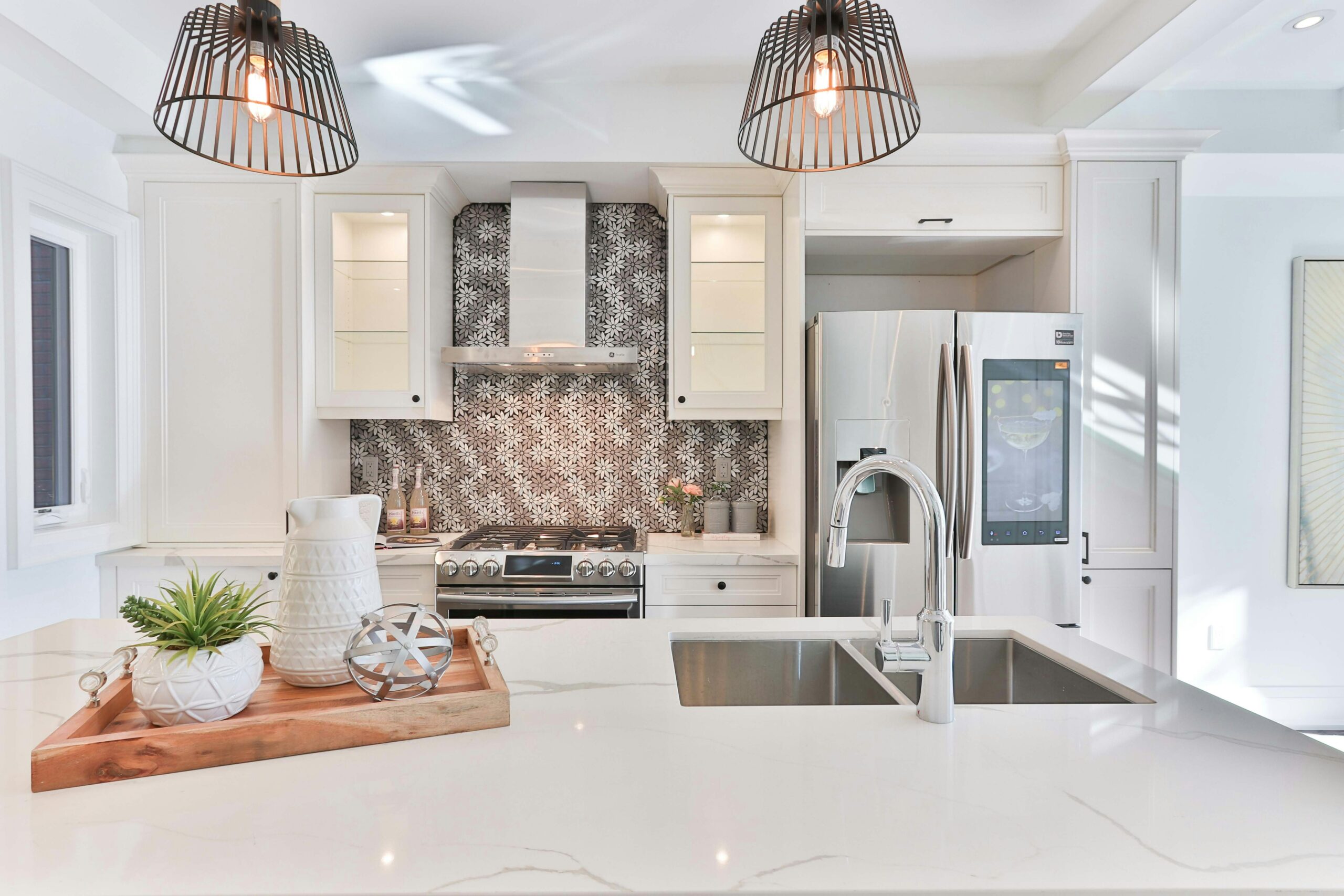Discover the timeless elegance and functional beauty brought about by marble kitchen countertops. These counters are more than just a slab of natural stone – they’re a testament to nature’s astounding ability to amaze us with its array of intricate details. Marble is often heralded as a symbol of luxury and sophistication and for good reason. The unique patterns, the cool touch, and the luminous look of marble adds to its charm, making it a beloved choice for modern and classic kitchens alike.
Throughout this comprehensive guide, we will delve into not only the clear-cut beauty of marble but also its interplay with various design styles. From understanding the inherently beautiful attributes of marble to taking well-sorted steps toward its installation, you will gain a profound understanding of this kitchen trend.
Moreover, you will be familiarizing yourself with how to maintain marble kitchen countertops and the factors that influence its pricing. Fret not, those who’re considering marble but concerned about its durability, we’ve got you covered with a section dedicated to its lifespan and sturdiness.
Are you ready to join us on this journey and explore the world of marble countertops? Stick around as we discuss Marble vs. Granite, delve into personalizing your space, weigh up the benefits, and much more in our forthcoming sections.
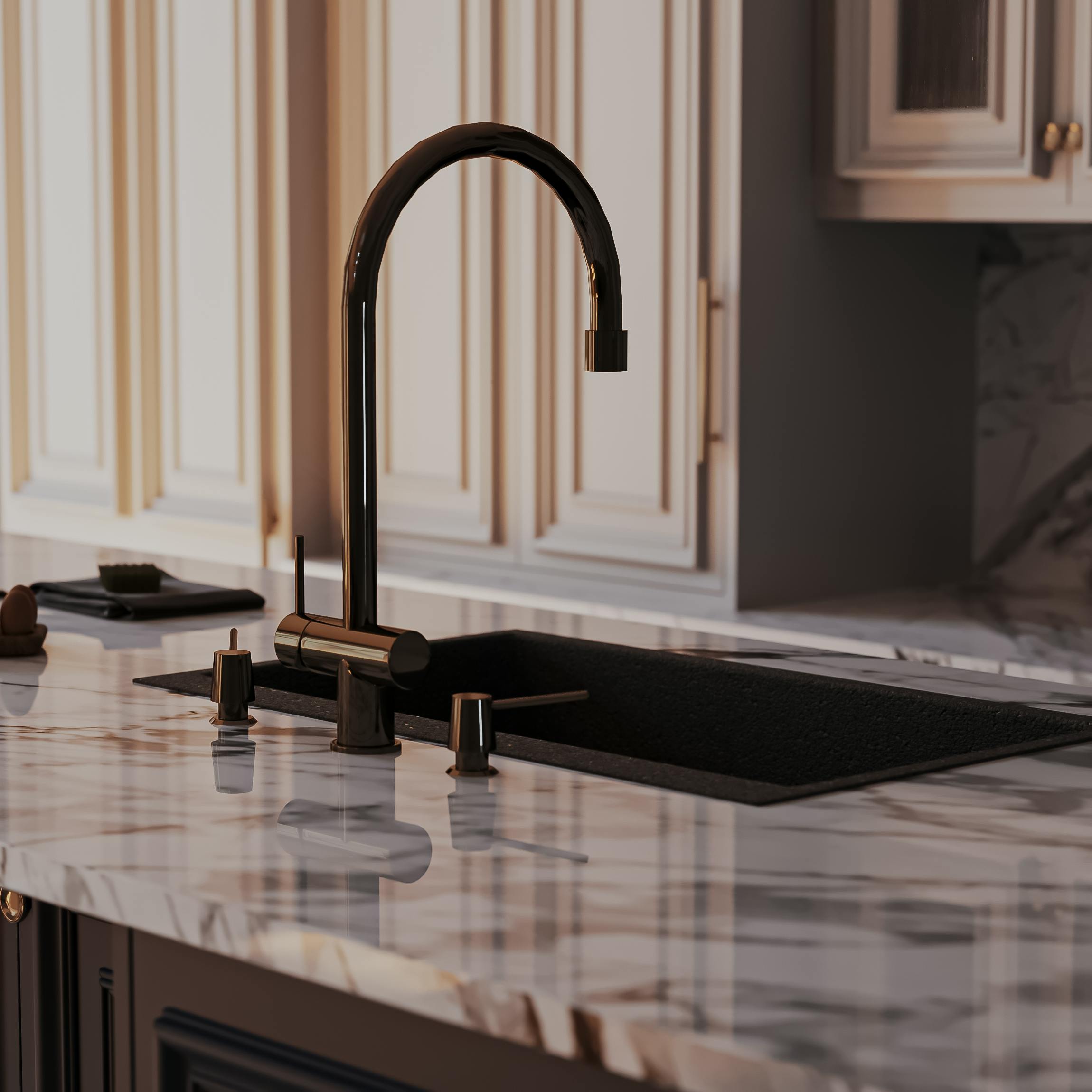
Understanding the Beauty of Marble Kitchen Countertops
Marble kitchen countertops are a popular choice among homeowners due to their timeless beauty and elegance. The natural veining and unique patterns of marble add a touch of luxury to any kitchen space. Understanding the beauty of marble kitchen countertops involves appreciating their aesthetic appeal and the way they can enhance the overall design of your kitchen.
One of the most striking features of marble countertops is their smooth and polished surface. The glossy finish reflects light, creating a bright and airy atmosphere in the kitchen. This can make even a small kitchen feel more spacious and inviting. The natural colors of marble, ranging from white and cream to gray and black, can also complement a wide range of kitchen styles and color schemes.
Marble countertops are known for their veining, which adds depth and character to the surface. Each slab of marble is unique, with its own intricate patterns and colors. This natural variation gives marble countertops a one-of-a-kind look that cannot be replicated with other materials. Whether you prefer a subtle and understated design or a bold and dramatic statement, there is a marble countertop that can perfectly suit your taste and style.
In addition to their visual appeal, marble kitchen countertops also offer practical benefits. The smooth surface of marble is ideal for rolling out dough and working with pastry. It is also heat-resistant, making it a suitable surface for placing hot pots and pans directly from the stove. However, it is important to note that marble is a porous material and can be susceptible to staining and etching. Proper maintenance and sealing are essential to keep marble countertops looking their best.
Overall, understanding the beauty of marble kitchen countertops involves appreciating their aesthetic appeal, unique patterns, and practical benefits. Whether you are looking to create a classic, contemporary, or eclectic kitchen design, marble countertops can be a stunning addition that elevates the overall look and feel of your space.

How to Maintain Marble Kitchen Countertops
Marble kitchen countertops are a beautiful addition to any home, but they require proper maintenance to keep them looking their best. Here are some essential tips to help you maintain the beauty and durability of your marble kitchen countertops:
1. Clean spills immediately
Marble is a porous material, which means it can easily absorb liquids and stains. To prevent staining, it’s crucial to clean up spills as soon as they happen. Use a soft cloth or sponge and mild soap to gently clean the affected area. Avoid using abrasive cleaners or scrub brushes, as they can scratch the surface of the marble.
2. Use coasters and trivets
Marble countertops are susceptible to heat damage and etching caused by acidic substances like citrus juices and vinegar. To protect your countertops, always use coasters under glasses and trivets under hot pots and pans. This will help prevent any direct contact between the marble and potentially damaging substances.
3. Seal the marble regularly
Sealing your marble kitchen countertops is essential to protect them from stains and etching. A high-quality marble sealer creates a protective barrier that prevents liquids from seeping into the stone. Follow the manufacturer’s instructions for application and reapply the sealer as recommended to maintain its effectiveness.
4. Avoid using harsh cleaning products
When cleaning your marble countertops, it’s important to avoid using harsh cleaning products that can damage the stone. Acidic or abrasive cleaners, such as bleach, ammonia, or vinegar, should be avoided. Instead, opt for gentle, pH-neutral cleaners specifically designed for marble surfaces.
5. Use cutting boards and chopping mats
While marble is a durable material, it can still be scratched or damaged by sharp knives. To protect your countertops, always use cutting boards or chopping mats when preparing food. This will prevent any direct contact between the knives and the marble surface, preserving its beauty and integrity.
6. Regularly dust and wipe down the countertops
To keep your marble countertops looking their best, it’s important to regularly dust and wipe them down. Use a soft, microfiber cloth to remove any dust or debris from the surface. Avoid using abrasive materials that can scratch the marble. For a deeper clean, dampen the cloth with water and a mild soap solution.
7. Avoid placing heavy objects on the countertops
Marble is a strong material, but it can still crack or chip under extreme pressure. Avoid placing heavy objects directly on your countertops to prevent any potential damage. Use caution when handling heavy kitchen appliances or moving furniture near the countertops to avoid accidents.
By following these maintenance tips, you can ensure that your marble kitchen countertops remain beautiful and functional for years to come. With proper care, your countertops will continue to enhance the overall aesthetic of your kitchen and provide a durable surface for all your culinary needs.
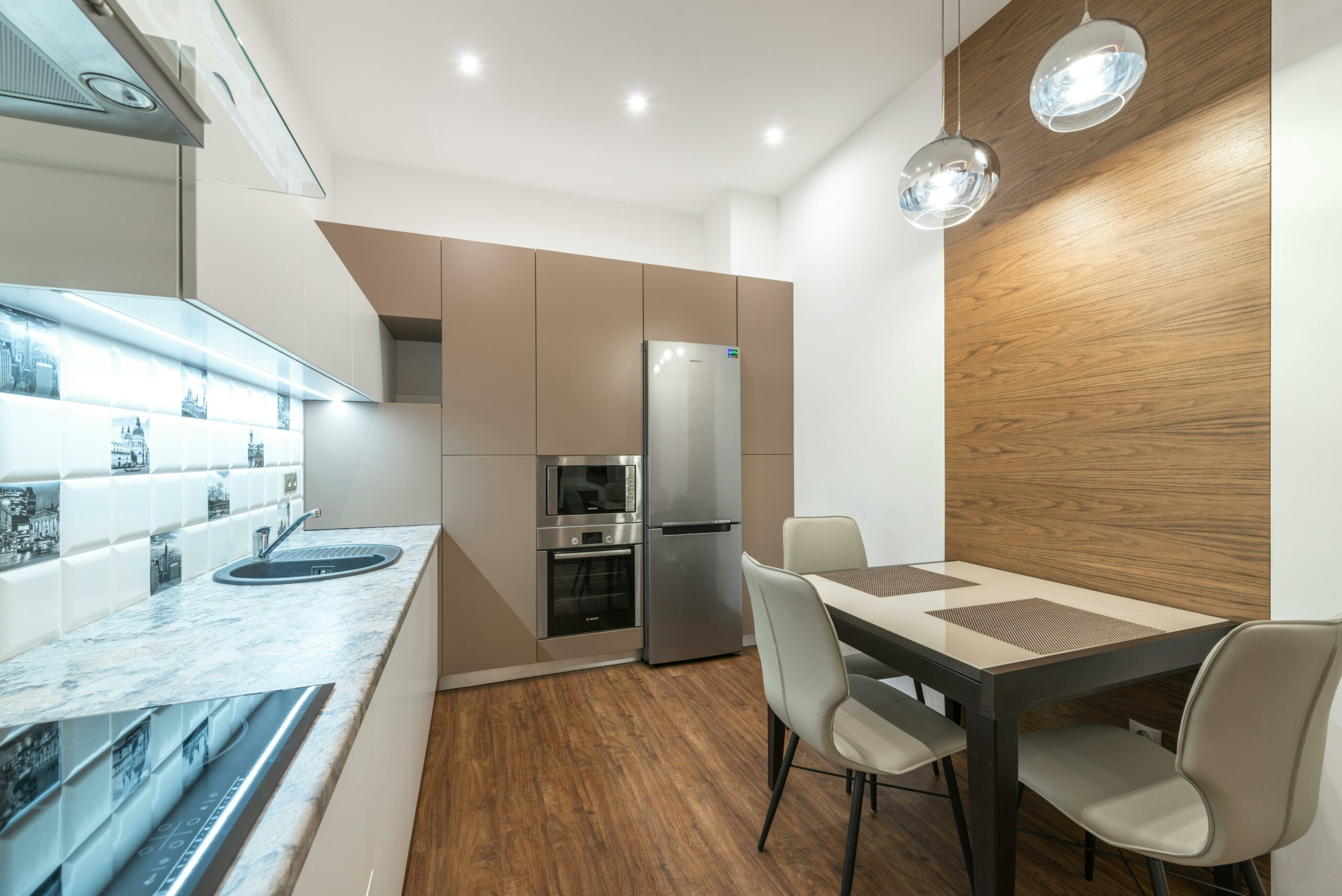
Top Benefits of Choosing Marble Kitchen Countertops
Marble kitchen countertops offer a range of benefits that make them a popular choice among homeowners. From their timeless beauty to their durability and versatility, marble countertops can enhance the overall look and functionality of your kitchen. Here are some of the top benefits of choosing marble kitchen countertops:
1. Elegant and Timeless Appearance
Marble is known for its luxurious and elegant appearance, adding a touch of sophistication to any kitchen. With its unique veining patterns and natural variations, marble countertops create a beautiful focal point that can elevate the aesthetic appeal of your kitchen.
2. Heat Resistance
Marble is a natural stone that has excellent heat resistance properties. This makes it an ideal choice for kitchen countertops, as it can withstand high temperatures without being damaged or discolored. You can place hot pots and pans directly on the surface of marble countertops without worrying about any heat-related issues.
3. Durability
Despite its elegant appearance, marble is a durable material that can withstand the daily wear and tear of a busy kitchen. When properly sealed and maintained, marble countertops can last for many years, making them a long-term investment for your home.
4. Versatility
Marble is available in a wide range of colors and patterns, allowing you to choose the perfect option that complements your kitchen’s design style. Whether you prefer a classic white marble or a more dramatic and veined variety, there is a marble countertop option to suit every taste and aesthetic.
5. Cool Surface
One of the unique benefits of marble countertops is their ability to stay cool, even in hot weather. This makes them a great surface for rolling out dough or working with pastry, as the cool temperature helps prevent the dough from sticking and makes it easier to handle.
6. Easy to Clean and Maintain
Marble countertops are relatively easy to clean and maintain. With regular sealing and proper care, they can resist staining and remain looking pristine for years to come. Spills and messes can be easily wiped away with a mild soap and water solution, keeping your kitchen countertops hygienic and beautiful.
7. Increase Home Value
Investing in marble kitchen countertops can significantly increase the value of your home. The timeless beauty and durability of marble are highly sought after by homebuyers, making it an attractive feature that can set your kitchen apart from others on the market.
Overall, marble kitchen countertops offer a range of benefits that make them a popular choice among homeowners. From their elegant appearance to their durability and versatility, marble countertops can transform your kitchen into a stylish and functional space.
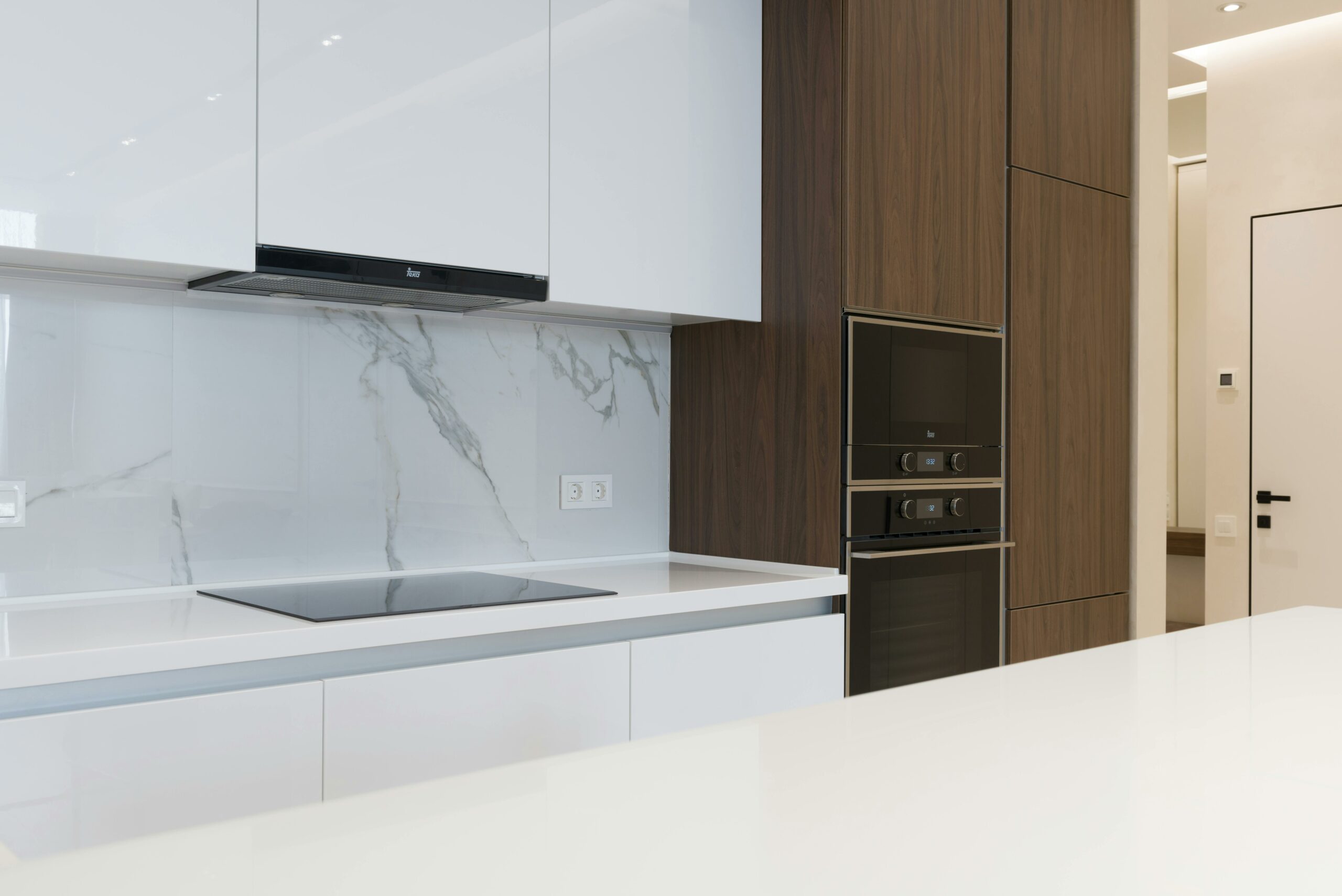
Selecting the Perfect Marble for Your Kitchen Countertops
When it comes to choosing marble for your kitchen countertops, there are several factors to consider. From the type of marble to the color and veining patterns, each decision will contribute to the overall look and feel of your kitchen. Here are some key points to keep in mind:
1. Type of Marble
There are various types of marble available, each with its own unique characteristics. Some popular options include Carrara, Calacatta, Statuario, and Emperador. Research each type to determine which one best fits your aesthetic preferences and budget.
2. Color and Veining
Marble comes in a wide range of colors, from white and gray to beige and even green. Consider the color scheme of your kitchen and choose a marble that complements it. Additionally, pay attention to the veining patterns, as they can add depth and visual interest to your countertops.
3. Durability
While marble is known for its beauty, it is important to note that it is a softer and more porous stone compared to granite. This means it is more prone to scratches, stains, and etching. Consider your lifestyle and how much maintenance you are willing to put into your countertops before making a decision.
4. Budget
Marble can vary significantly in price, depending on the type, quality, and availability. Set a budget for your kitchen countertops and explore different options within that range. Remember to consider the long-term investment and potential resale value of your home.
5. Samples and Visualizing
Before making a final decision, it is recommended to obtain samples of the marble you are considering. This will allow you to see how it looks in your kitchen’s lighting and alongside your cabinetry and flooring. Visualizing the end result will help you make a more informed choice.
By considering these factors and taking your time to research and explore different options, you can select the perfect marble for your kitchen countertops. Remember, your countertops are not only functional but also a statement piece that adds elegance and sophistication to your kitchen.
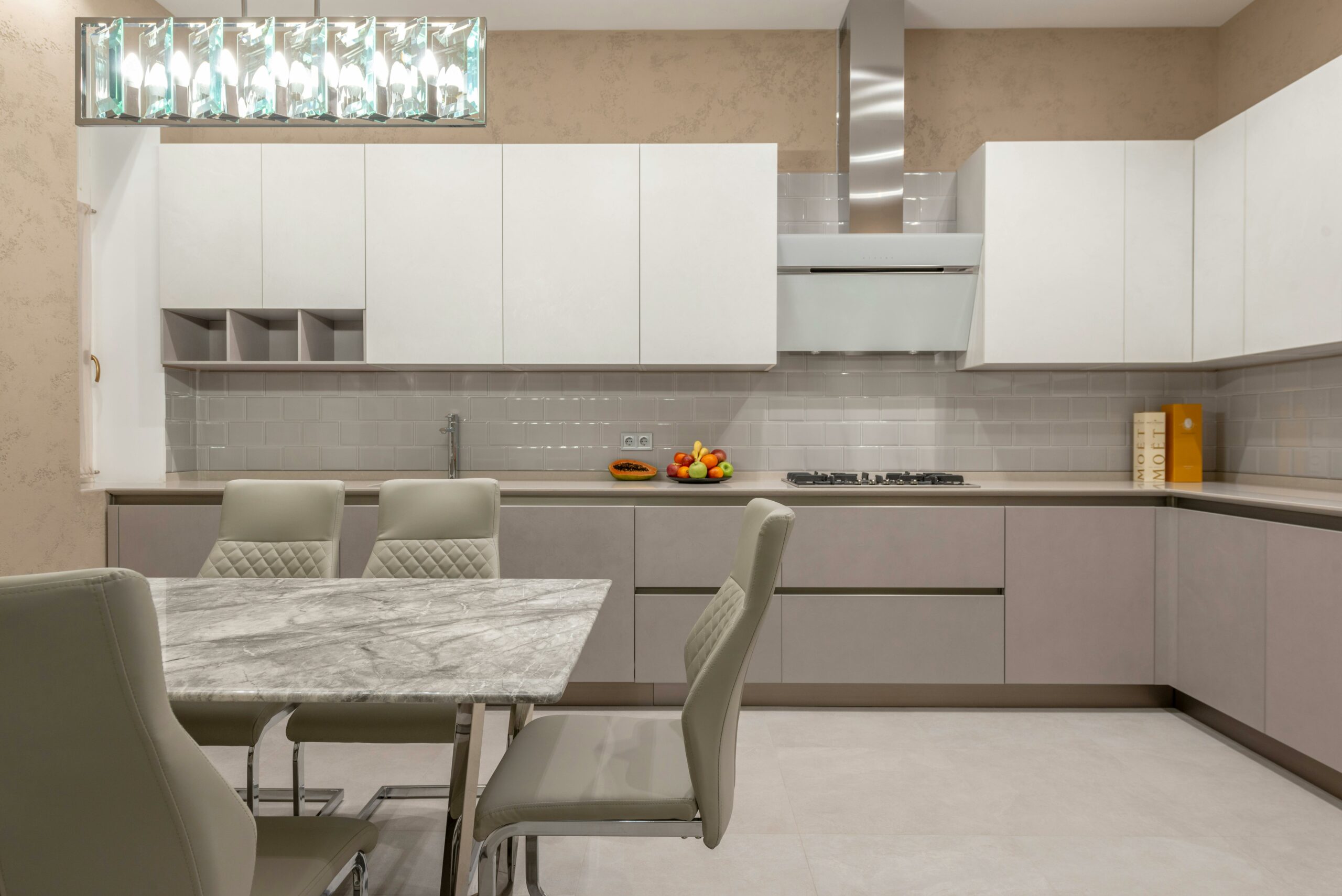
Incorporating Marble Kitchen Countertops into Various Design Styles
Marble kitchen countertops are not only durable and functional, but they also add a touch of elegance and sophistication to any kitchen. Whether you have a traditional, modern, or eclectic design style, marble countertops can seamlessly blend into your kitchen decor. Here are some ideas on how to incorporate marble kitchen countertops into various design styles:
1. Traditional Design Style
In a traditional kitchen, marble countertops can enhance the classic and timeless look. Opt for Carrara marble with its white and gray veins for a traditional aesthetic. Pair it with wooden cabinets, ornate hardware, and a farmhouse sink for a charming and elegant kitchen.
2. Modern Design Style
In a modern kitchen, marble countertops can add a sleek and luxurious touch. Choose Calacatta marble with its bold and dramatic veining for a contemporary look. Pair it with minimalist white cabinets, stainless steel appliances, and clean lines for a modern and sophisticated kitchen.
3. Eclectic Design Style
In an eclectic kitchen, marble countertops can be a statement piece that adds personality and visual interest. Consider a unique marble variety like Nero Marquina with its black background and white veins. Pair it with colorful cabinets, vintage accessories, and eclectic decor for a one-of-a-kind kitchen.
No matter the design style you choose, it’s important to consider the overall color scheme and materials in your kitchen to ensure that the marble countertops complement the space harmoniously. With proper care and maintenance, marble kitchen countertops can be a stunning addition to any design style.
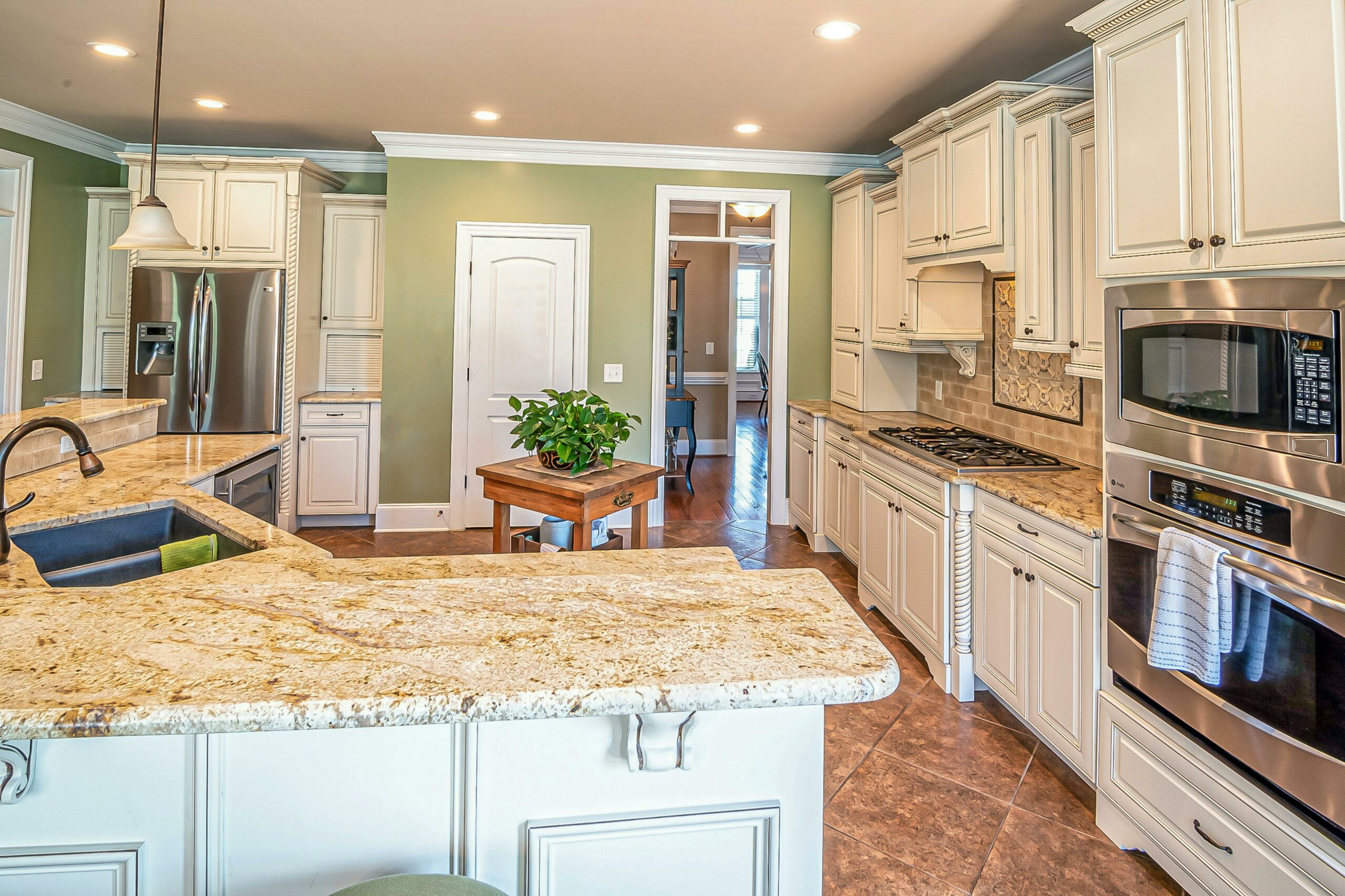
Installing Marble Kitchen Countertops: A Step-by-Step Guide
Installing marble kitchen countertops can be a rewarding project that adds elegance and beauty to your kitchen. Follow this step-by-step guide to ensure a successful installation:
1. Measure and Plan
Start by measuring your kitchen countertops to determine the amount of marble needed. Consider the layout and any special features, such as sinks or cooktops. Create a detailed plan to guide you through the installation process.
2. Prepare the Surface
Before installing the marble, ensure that the surface is clean, level, and free of any debris. Repair any cracks or damage to ensure a smooth installation.
3. Cut and Shape the Marble
Using a diamond-blade wet saw, carefully cut the marble slabs according to your measurements. Take your time to ensure accurate cuts and smooth edges.
4. Apply Adhesive
Using a high-quality adhesive, apply a thin layer to both the surface and the back of the marble slabs. This will ensure a strong bond between the marble and the countertop.
5. Place the Marble
Carefully place the marble slabs onto the adhesive, starting from one end and working your way to the other. Use a rubber mallet to gently tap the slabs into place and ensure a secure fit.
6. Secure the Marble
Once all the slabs are in place, use clamps and supports to hold them in position while the adhesive dries. Follow the manufacturer’s instructions for the recommended drying time.
7. Seal the Marble
After the adhesive has dried, apply a high-quality sealer to protect the marble from stains and damage. Follow the sealer manufacturer’s instructions for the best results.
8. Clean and Maintain
Regularly clean and maintain your marble kitchen countertops to keep them looking their best. Use a mild soap and warm water for everyday cleaning, and avoid using abrasive cleaners or harsh chemicals.
By following these steps, you can successfully install marble kitchen countertops and enjoy their beauty and durability for years to come.

Personalizing Your Space with Marble Kitchen Countertops
Marble kitchen countertops are not only a practical choice for your kitchen, but they also add a touch of elegance and sophistication to your space. With their unique veining patterns and natural beauty, marble countertops can truly personalize your kitchen and make it stand out.
Choosing the Right Color and Pattern
When it comes to personalizing your space with marble kitchen countertops, selecting the right color and pattern is crucial. Marble comes in a variety of colors, ranging from classic white to shades of gray, beige, and even black. Each color has its own unique characteristics and can create a different atmosphere in your kitchen. Additionally, the veining patterns in marble can vary greatly, from subtle and delicate to bold and dramatic. Consider your overall kitchen design and personal style when choosing the perfect marble color and pattern.
Adding Custom Edges
To further personalize your marble kitchen countertops, you can choose custom edges. The edge profile of your countertops can make a significant difference in the overall look and feel of your kitchen. Whether you prefer a sleek and modern straight edge or a more intricate and decorative edge, there are plenty of options to choose from. Custom edges can add a unique touch to your countertops and help create the desired aesthetic in your kitchen.
Incorporating Accessories and Decor
Another way to personalize your space with marble kitchen countertops is by incorporating accessories and decor. Marble countertops provide a versatile backdrop for various kitchen accessories, such as cutting boards, utensil holders, and decorative items. You can also add personal touches with plants, artwork, or statement pieces that complement the elegance of the marble. These accessories and decor elements can enhance the overall ambiance of your kitchen and reflect your personal style.
Creating a Focal Point
If you want to make a bold statement with your marble kitchen countertops, consider creating a focal point. This can be achieved by using a different marble color or pattern for a specific area of your kitchen, such as the kitchen island or a backsplash. By creating a focal point, you can draw attention to certain areas and add visual interest to your space. This personalized touch can elevate the design of your kitchen and make it truly unique.
Maintaining the Beauty of Marble
Lastly, to ensure that your marble kitchen countertops continue to personalize your space for years to come, it is important to properly maintain them. Regular cleaning and sealing will help protect the marble from stains and scratches, preserving its beauty and longevity. By following the recommended maintenance practices, you can enjoy the personalized elegance of marble in your kitchen for a long time.

Pricing Factors for Marble Kitchen Countertops
When considering marble kitchen countertops for your home, it’s important to understand the various factors that can influence the pricing. Here are some key factors to consider:
1. Quality of the Marble
The quality of the marble itself plays a significant role in determining the price. High-quality marble with minimal imperfections and a desirable color and pattern will typically be more expensive.
2. Size and Thickness
The size and thickness of the marble slabs required for your kitchen countertops will also impact the price. Larger slabs and thicker countertops will generally cost more due to the increased material and labor involved.
3. Complexity of the Design
If you have a complex design or require intricate cuts and shapes for your marble countertops, the price will likely be higher. Customized designs and unique edge profiles may require additional time and expertise, resulting in increased costs.
4. Installation Costs
The cost of installation should also be factored into the overall pricing. Experienced professionals will ensure proper installation, which may include leveling, sealing, and joining the marble slabs seamlessly. The complexity of the installation process can affect the overall price.
5. Additional Features and Accessories
Consider any additional features or accessories you may want to incorporate into your marble kitchen countertops. This could include sink cutouts, backsplashes, or decorative elements. These additions will contribute to the overall cost.
6. Supplier and Location
The supplier you choose and your location can also impact the pricing. Different suppliers may offer varying prices for the same marble, and location can affect transportation costs. Research and compare different suppliers to ensure you are getting the best value for your money.
By considering these factors, you can better understand the pricing of marble kitchen countertops and make an informed decision that suits your budget and design preferences.
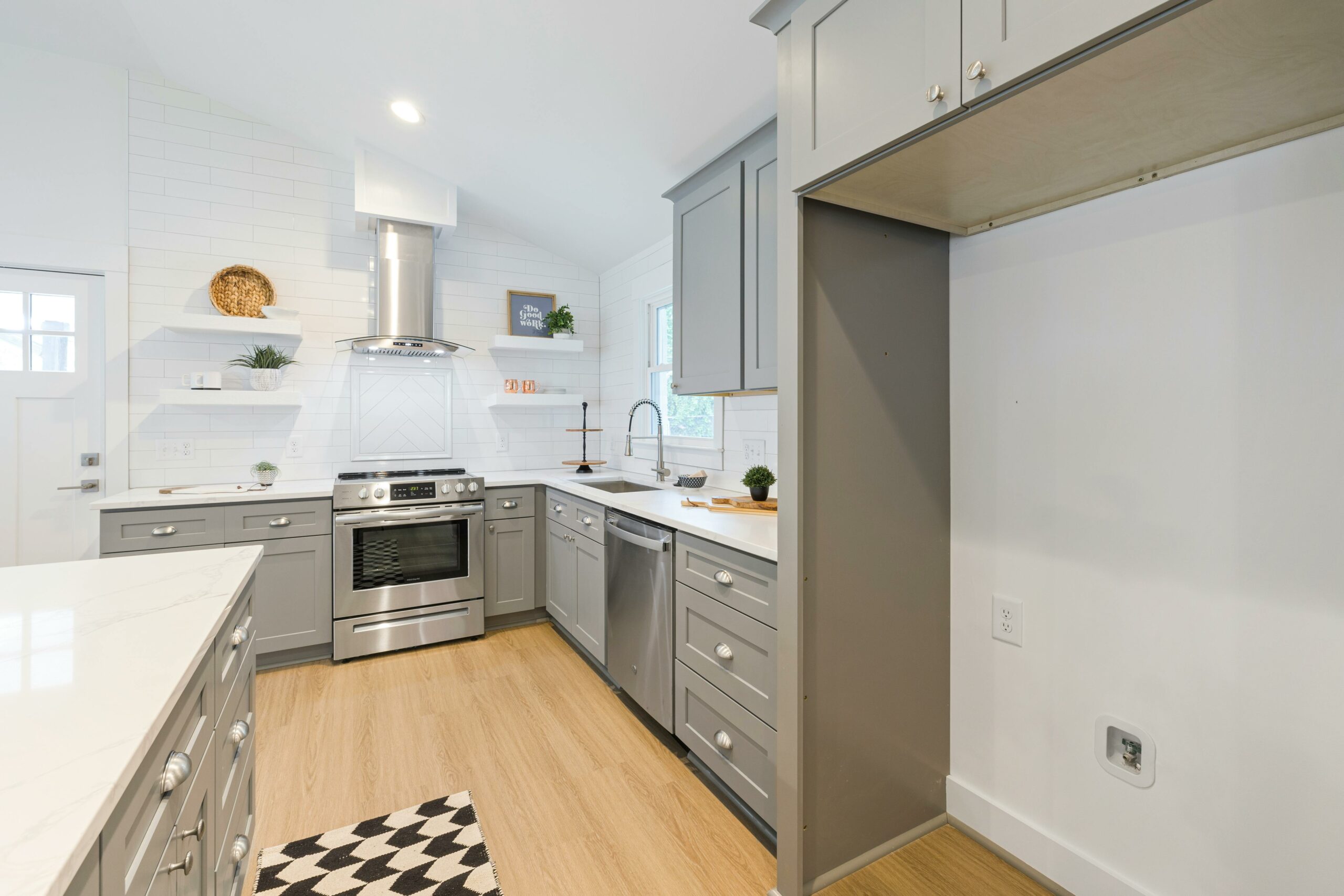
Marble Kitchen Countertops Versus Granite: A Comparison
When it comes to choosing the perfect kitchen countertop material, two options often come to mind: marble and granite. Both of these natural stones offer unique characteristics and can enhance the beauty of your kitchen. However, there are some key differences between them that you should consider before making a decision. In this article, we will compare marble kitchen countertops to granite countertops, highlighting their similarities and differences.
Appearance
One of the main reasons why homeowners choose marble kitchen countertops is for their stunning appearance. Marble has a timeless and elegant look that can instantly elevate the aesthetic of any kitchen. It features unique veining patterns and a wide range of colors, from classic white to rich gray and even bold black. On the other hand, granite countertops also offer a beautiful and natural look, but with a more speckled and granular appearance. Granite comes in a variety of colors, including shades of white, black, brown, and red.
Durability
When it comes to durability, granite is known for its strength and resilience. It is a harder and more durable material compared to marble, making it less prone to scratches and chips. Granite is also heat-resistant, which means you can place hot pots and pans directly on the countertop without worrying about damage. On the other hand, while marble is a durable material, it is softer and more porous than granite. This means that it is more susceptible to scratches, stains, and etching from acidic substances.
Maintenance
Proper maintenance is essential to keep your kitchen countertops looking their best. Granite countertops are relatively low-maintenance and easy to clean. They require sealing every few years to maintain their stain resistance. On the other hand, marble countertops require more care and attention. They should be sealed regularly to protect against stains and etching. It is also important to avoid using harsh or acidic cleaners on marble surfaces to prevent damage.
Cost
Another important factor to consider is the cost of marble and granite kitchen countertops. Generally, granite countertops are more affordable compared to marble. The price of marble can vary depending on the quality, color, and rarity of the stone. Additionally, the cost of installation may also differ between the two materials.
Conclusion
Both marble and granite kitchen countertops have their own unique advantages and considerations. Marble offers a timeless and elegant look, while granite provides durability and strength. When making a decision, it is important to consider your personal preferences, budget, and lifestyle. Ultimately, both materials can enhance the beauty of your kitchen and add value to your home.
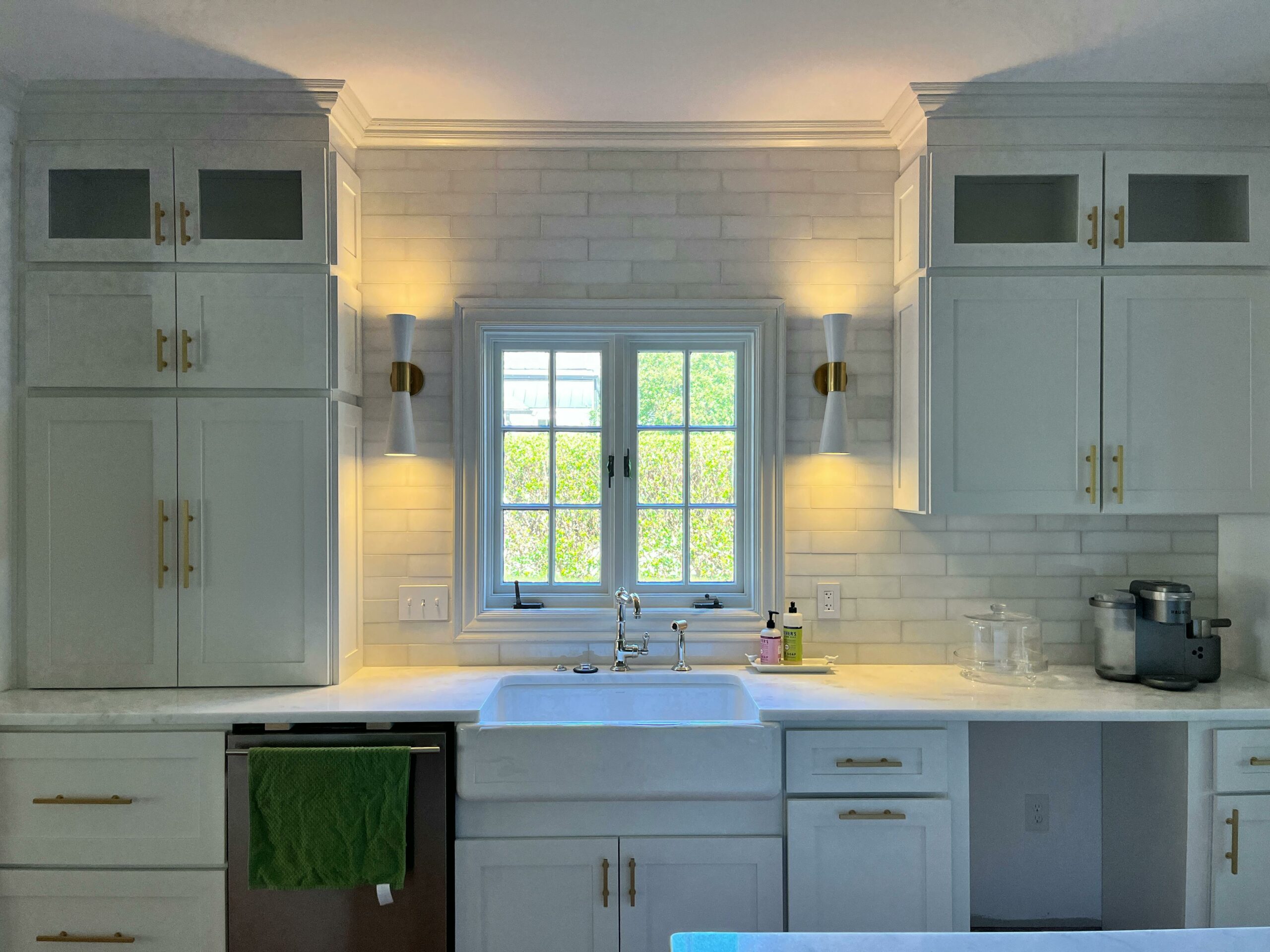
The Lifespan and Durability of Marble Kitchen Countertops
Marble kitchen countertops are not only known for their beauty and elegance, but they also offer impressive durability and a long lifespan. Understanding the lifespan and durability of marble countertops can help you make an informed decision when choosing the right material for your kitchen.
Lifespan of Marble Kitchen Countertops
When properly cared for, marble kitchen countertops can last for decades. The lifespan of marble countertops largely depends on how well they are maintained and how they are used. With regular cleaning and sealing, you can ensure that your marble countertops remain in excellent condition for a long time.
Durability of Marble Kitchen Countertops
Marble is a natural stone that is formed under intense heat and pressure. This process gives marble its unique veining and makes it a durable material for kitchen countertops. While marble is not as hard as granite, it still offers a high level of durability and can withstand everyday use in the kitchen.
However, it’s important to note that marble is a softer stone compared to granite and quartz. This means that it may be more prone to scratches and etching from acidic substances like lemon juice or vinegar. To protect the surface of your marble countertops, it’s recommended to use cutting boards and avoid placing hot pans directly on the surface.
Maintaining the Durability of Marble Kitchen Countertops
To maintain the durability of marble kitchen countertops, it’s crucial to follow proper care and maintenance practices. This includes regular cleaning with a mild soap and water solution, avoiding harsh chemicals or abrasive cleaners that can damage the surface.
Additionally, it’s essential to seal your marble countertops regularly to protect them from stains and moisture penetration. A high-quality marble sealer will help maintain the durability and longevity of your countertops.
It’s also important to address any stains or scratches on your marble countertops promptly. Using a poultice or a specialized marble cleaner can help remove stains and restore the beauty of your countertops.
By following these maintenance tips and taking proper care of your marble kitchen countertops, you can ensure their durability and enjoy their timeless beauty for many years to come.

